Praktica Z212 Manual
Preface
About this Manual
•The contents of this manual and the bundled Basic Reference are subject to change without notice.
•Note that the example screens and product illustrations shown in this
User’s Guide may differ somewhat from the screens and configuration of the actual camera.
Copyright
This manual contains proprietary information protected by copyright. All rights are reserved. No part of this manual may be reproduced by any mechanical, electronic or other means, in any form, without prior written permission of the manufacturer.
© Copyright 2015
Declaration of Conformity
This device complies with Part 15 of the FCC rules. Operation is subject to the following conditions:
•This device may not cause harmful interference.
•This device must accept any interference received, including interference that may cause undesired operation.
CE Mark Warning
This is a Class B product, in a domestic environment, this product may cause radio interference, in which case the user may be required to take adequate measures.
FCC: SAR standard Value: 1.6 W/Kg, Maximal Measure: 0.27 W/Kg CE: SAR standard Value: 2.0 W/Kg, Maximal Measure: 0.077 W/Kg
Trademark Recognition
Windows XP/Vista/Win7/Win 8 are registered trademarks of Microsoft Corporation in the United States and/or other countries. Windows is an abbreviated term referring to the Microsoft Windows Operation System. All other companies or product names are trademarks or registered trademarks of their respective companies.
Federal Communication Commission Interference Statement
APPLIES TO USA AND CANADA ONLY
This device complies with Part 15 of the FCC Rules. Operation is subject to the following two conditions: (1) This device may not cause harmful interference,
1
and (2) this device must accept any interference received, including interference that may cause undesired operation.
This equipment has been tested and found to comply with the limits for a Class B digital device, pursuant to Part 15 of the FCC Rules. These limits are designed to provide reasonable protection against harmful interference in a residential installation. This equipment generates, uses and can radiate radio frequency energy and, if not installed and used in accordance with the instructions, may cause harmful interference to radio communications. However, there is no guarantee that interference will not occur in a particular installation. If this equipment does cause harmful interference to radio or television reception, which can be determined by turning the equipment off and on, the user is encouraged to try to correct the interference by one of the following measures:
•Reorient or relocate the receiving antenna.
•Increase the separation between the equipment and receiver.
•Connect the equipment into an outlet on a circuit different from that to which the receiver is connected.
•Consult the dealer or an experienced radio/TV technician for help.
FCC Caution: Any changes or modifications not expressly approved by the party responsible for compliance could void the user's authority to operate this equipment.
This transmitter must not be co-located or operating in conjunction with any other antenna or transmitter.
Radiation Exposure Statement:
This equipment complies with FCC radiation exposure limits set forth for an uncontrolled environment. This equipment should be installed and operated with minimum distance 20cm between the radiator & your body.
This device is intended only for OEM integrators under the following conditions:
1)The antenna must be installed such that 20 cm is maintained between the antenna and users, and
2)The transmitter module may not be co-located with any other transmitter or antenna.
As long as 2 conditions above are met, further transmitter test will not be required. However, the OEM integrator is still responsible for testing their endproduct for any additional compliance requirements required with this module installed.
2
IMPORTANT NOTE: In the event that these conditions can not be met (for example certain laptop configurations or co-location with another transmitter), then the FCC authorization is no longer considered valid and the FCC ID can not be used on the final product. In these circumstances, the OEM integrator will be responsible for re-evaluating the end product (including the transmitter) and obtaining a separate FCC authorization.
End Product Labelling
This transmitter module is authorized only for use in a device where the antenna may be installed such that 20 cm may be maintained between the antenna and users. The final end product must be labelled in a visible area with the following: "Contains FCC ID: 2AAD3AA0D0". The grantee's FCC ID can be used only when all FCC compliance requirements are met.
Manual Information To the End User
The OEM integrator has to be aware not to provide information to the end user regarding how to install or remove this RF module in the user’s manual of the end product which integrates this module.
The end user manual shall include all required regulatory information/warning as shown in this manual.
Industry Canada statement
This device complies with RSS-210 of the Industry Canada Rules. Operation is subject to the following two conditions: (1) This device may not cause harmful interference, and (2) this device must accept any interference received, including interference that may cause undesired operation.
Ce dispositif est conforme à la norme CNR-210 d'Industrie Canada applicable aux appareils radio exempts de licence. Son fonctionnement est sujet aux deux conditions suivantes: (1) le dispositif ne doit pas produire de brouillage préjudiciable, et (2) ce dispositif doit accepter tout brouillage reçu, y compris un brouillage susceptible de provoquer un fonctionnement indésirable.
This device is intended only for OEM integrators under the following conditions: (For module device use)
1)The antenna must be installed such that 20 cm is maintained between the antenna and users, and
2)The transmitter module may not be co-located with any other transmitter or antenna.
As long as 2 conditions above are met, further transmitter tests will not be required. However, the OEM integrator is still responsible for testing their endproduct for any additional compliance requirements when this module is installed.
3
Cet appareil est conçu uniquement pour les intégrateurs OEM dans les conditions suivantes: (Pour utilisation de dispositif module)
1)L'antenne doit être installée de telle sorte qu'une distance de 20 cm est respectée entre l'antenne et les utilisateurs, et
2)Le module émetteur peut ne pas être coïmplanté avec un autre émetteur ou antenne.
Tant que les 2 conditions ci-dessus sont remplies, des essais supplémentaires sur l'émetteur ne seront pas nécessaires. Toutefois, l'intégrateur OEM est toujours responsable des essais sur son produit final pour toutes exigences de conformité supplémentaires requis pour ce module installé.
IMPORTANT NOTE: In the event that these conditions cannot be met (for example certain laptop configurations or co-location with another transmitter), then the Canada authorization is no longer considered valid and the IC ID can not be used on the final product. In these circumstances, the OEM integrator will be responsible for re-evaluating the end product (including the transmitter) and obtaining a separate Canada authorization.
NOTE IMPORTANTE : Dans le cas où ces conditions ne peuvent être satisfaites (par exemple pour certaines configurations d'ordinateur portable ou de certaines co-localisation avec un autre émetteur), l'autorisation du Canada n'est plus considéré comme valide et l'ID IC ne peut pas être utilisé sur le produit final. Dans ces circonstances, l'intégrateur OEM sera chargé de réévaluer le produit final (y compris l'émetteur) et l'obtention d'une autorisation distincte au Canada.
End Product Labelling
This transmitter module is authorized only for use in device where the antenna may be installed such that 20 cm may be maintained between the antenna and users. The final end product must be labelled in a visible area with the following: "Contains IC: 10290A-AA0D0".
Plaque signalétique du produit final
Ce module émetteur est autorisé uniquement pour une utilisation dans un dispositif où l'antenne peut être installée de telle sorte qu'une distance de 20cm peut être maintenue entre l'antenne et les utilisateurs. Le produit final doit être étiqueté dans un endroit visible avec l'inscription suivante: "Contient des IC: 10290A-AA0D0".
Manual Information To the End User
The OEM integrator has to be aware not to provide information to the end user regarding how to install or remove this RF module in the user’s manual of the end product which integrates this module.
4
The end user manual shall include all required regulatory information/warning as shown in this manual.
Manuel d'information à l'utilisateur final
L'intégrateur OEM doit être conscient de ne pas fournir des informations à l'utilisateur final quant à la façon d'installer ou de supprimer ce module RF dans le manuel de l'utilisateur du produit final qui intègre ce module.
Le manuel de l'utilisateur final doit inclure toutes les informations réglementaires requises et avertissements comme indiqué dans ce manuel.
Safety and Handling Precautions
Camera Information
•Do not take apart or attempt to service the camera yourself.
•Do not expose the camera to moisture, or extreme temperatures.
•Allow the camera to warm up when moving from cold to warm temperatures.
•Do not touch and put pressure on the camera lens.
•Do not expose the lens to direct sunlight for extended periods.
•Do not use abrasive chemicals, cleaning solvents or strong detergents to clean the product. Wipe the product with a slightly damp soft cloth.
•Do not use the flash or LED Light near a person's eyes to prevent possible eye injury.
•To prevent you from falling over or resulting in traffic accident, please do not use the camera while you are walking, driving or riding a vehicle.
•Please handle the camera strap with care, and never place the strap around the neck of an infant or child. Wrapping the strap around a neck may cause suffocation.
•Do not subject the LCD monitor to impact.
•To prevent the risk of fire or electric shock, do not expose this appliance to rain or moisture.
Battery Information
•Turn off the camera before installing or removing the battery.
•Use only the provided batteries or type of battery and charger that came with your camera. Using other types of batteries or chargers may damage the device and invalidate the warranty.
•Inserting the battery upside down can cause damage to the product and possibly cause an explosion.
5

•When the camera is used for an extended period of time, it is normal for the camera body to feel warm.
•Download all pictures and remove the battery from the camera if you are going to store the camera for a long period of time.
•The type of battery and the battery power level may cause the lens to stick. Ensure you use the correct battery type and use a fully charged battery.
•Risk of explosion if battery is replaced with an incorrect battery. Dispose of used batteries according to the instructions.
•Please keep the batteries out of the reach of children to prevent them from swallowing batteries, which might cause poisoning.
USB adapter Information
•Do not expose the adapter to high temperatures or places with high levels of moisture. Otherwise, it may cause a fire or electric shock.
•Do not attempt to repair, disassemble, change or transform the adapter.
•Avoid sudden changes in temperature, which may cause condensation on the adapter’s internal surfaces. Please do not use it immediately in this situation.
•Do not touch the plug with wet hands as it may cause an electric shock.
•Do not use the travel voltage converter or AC/DC power inverter. Otherwise, it may cause damage, overheating, malfunction or fire to the camera.
Using this Menu
Symbols used in this manual are explained below:
This indicates useful information when using your camera.
This indicates an important message that should be read before using the function.
6
Table of Contents
Preface ............................................................................................ |
1 |
About this Manual ....................................................................... |
1 |
Federal Communication Commission Interference Statement ......... |
1 |
Industry Canada statement ......................................................... |
3 |
Safety and Handling Precautions.................................................. |
5 |
Using this Menu .......................................................................... |
6 |
Introduction ................................................................................... |
10 |
System Requirements ............................................................... |
10 |
Main Features........................................................................... |
10 |
Package Contents ..................................................................... |
11 |
Camera Views........................................................................... |
12 |
Navigation Control .................................................................... |
15 |
Getting Started............................................................................... |
17 |
Attach the Camera Strap ........................................................... |
17 |
Inserting the Battery ................................................................. |
17 |
Camera Memory ....................................................................... |
18 |
Inserting a Micro SD/SDHC/SDXC Memory Card.......................... |
19 |
Charging the Battery by USB ..................................................... |
20 |
Turning the Power On and Off ................................................... |
20 |
Initial Settings .......................................................................... |
21 |
Modes ...................................................................................... |
21 |
Using the LCD monitor.................................................................... |
22 |
LCD Monitor Layout .................................................................. |
22 |
Recording Images and Videos ......................................................... |
27 |
Taking Images.......................................................................... |
27 |
Setting the Zoom Control .......................................................... |
27 |
Using EV Compensation ............................................................ |
28 |
Using Flash............................................................................... |
29 |
7 |
|
Using Self-timer ........................................................................ |
30 |
Setting the Focus Mode............................................................. |
31 |
Using the AE/AF LOCK/Delete Button ......................................... |
32 |
Recording Videos ...................................................................... |
35 |
Using the Record Menu ............................................................. |
48 |
Using the Movie Menu............................................................... |
57 |
Playback ........................................................................................ |
60 |
Viewing in Single Navigation...................................................... |
60 |
Viewing Thumbnails .................................................................. |
60 |
Magnify .................................................................................... |
62 |
Playing Videos .......................................................................... |
62 |
Playing Voice Memo .................................................................. |
63 |
Playback Menu.......................................................................... |
64 |
Using the Setup Menu .................................................................... |
75 |
Setting Sounds ......................................................................... |
75 |
Setting Power Save ................................................................... |
76 |
Setting Date & Time.................................................................. |
76 |
Setting Display Mode................................................................. |
77 |
Setting LCD Brightness.............................................................. |
77 |
Setting Format.......................................................................... |
77 |
Reset All................................................................................... |
78 |
Wi-Fi Settings ........................................................................... |
78 |
Using Wi-Fi function ....................................................................... |
79 |
Steps of connecting your digital camera and smart device ........... |
79 |
Making Connections........................................................................ |
86 |
Connecting the Camera to a PC ................................................. |
86 |
Connecting the Camera to a Printer ........................................... |
87 |
Setting the Print Mode Menu ..................................................... |
87 |
Appendix ....................................................................................... |
89 |
8 |
|
About Folder and File Names ..................................................... |
89 |
Troubleshooting ............................................................................. |
89 |
9
Introduction
Congratulations on the purchase of your new digital camera. Capturing highquality digital images is fast and easy with this state-of-the-art smart camera.
System Requirements
In order to get the most out of your camera, your computer must meet the following system requirements:
For Windows:
•Windows XP/Vista/Win7/Win8
•Processor: Intel Pentium D 3.0GHz or equivalent AMD Athlon, or faster
•Memory: 2 GB or above
•HDD space: 300MB or above
•32bit colour display monitor
•Microsoft DirectX 9.0C
•USB port and CD-ROM drive
For Macintosh:
•Mac OS 10.3.9 ~ 10.8 <Mass storage>
•Memory: 1 GB or above
•Q. Time player ver. 6.0.3 or above
•USB port and CD-ROM drive
Main Features
•20 mega pixels resolution
•Up to 12x optical zoom and 8x digital zoom
•3.0 inch colour LCD monitor
•64MB internal flash memory with optional external Micro SD/SDHC/SDXC card
•Supports up to 4GB Micro SD card, and up to 32GB Micro SDHC card and 64GB Micro SDXC card
•Easy-to-use button interface
•DCF, DPOF, PictBridge compatibility
•Slide show enables you to playback photos, videos and corrupted files
10
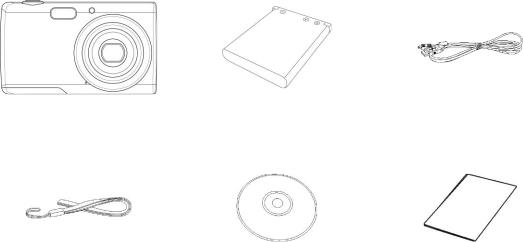
• USB port to transfer images and videos to your PC
Package Contents
Please check the contents of your camera package. It should contain:
Digital camera |
Rechargeable |
USB cable |
|
battery |
|
|
x 1 pcs |
|
Wrist strap |
CD-Rom |
Quick Start Guide |
11

Camera Views
Front View
1. |
Flash |
2. |
Self-timer |
|
LED/AF Assist |
|
Lamp |
3. |
Lens |
4. |
Microphone |
Back View
5. LCD monitor
6. LED indicator light
7. Movie button
8. AE/AF LOCK button/Delete
9. OK button/4-way navigation control
10. Menu button
11. Playback button
12
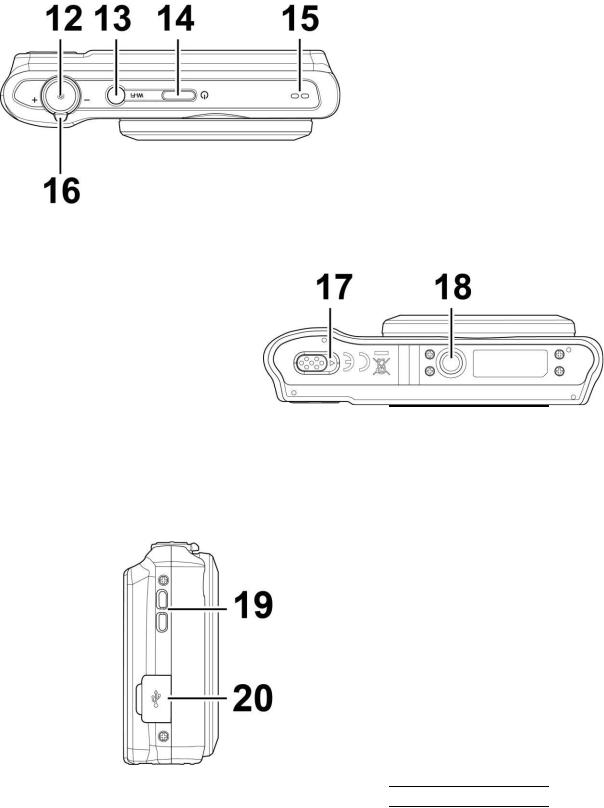
Top View
12. Shutter button
13. Wi-Fi button
14. Power button
15. Speaker
16. Zoom dial
Bottom View
17.Battery/Memory card compartment
18.Tripod screw hole
Right View
19. Strap ring
20. USB
13
Camera Buttons
Your camera is equipped with different buttons for ease of use.
|
Button |
|
Description |
|
|
|
|
|
Power |
|
Press the Power button to turn the power on/off. |
|
|
|
|
Shutter |
|
Press to capture an image. |
|
|
|
|
|
|
|
|
In Photo mode and Recording video, spin the zoom dial left to |
|
Zoom dial |
|
zoom out, right to zoom in. |
|
|
In Playback mode, spin to zoom in to magnify image or zoom out |
|
|
|
|
|
|
|
|
to enter thumbnails. |
|
|
|
|
Menu |
|
Press to enter or exit menu/submenu. |
|
|
|
|
|
|
|
|
Press this button on your camera to lock focus and exposure, or |
|
AE/AF LOCK |
|
delete an image, video or audio clip. See "Using the AE/AF |
|
button/Delete |
|
LOCK/Delete Button" on page 32 to know more about AE/AF |
|
|
|
LOCK/Delete button. |
|
|
|
|
Playback |
|
Press to enable Playback mode or return Record mode. |
|
|
|
|
|
|
Movie |
|
Press to start/stop recording video. |
|
|
|
|
Wi-Fi |
|
Press to enter or exit Wi-Fi menu. See "Using Wi-Fi" on page 79 |
|
|
to know more about Wi-Fi button. |
||
|
|
|
|
|
|
|
|
14

Navigation Control
The 4-way Navigation Control and the OK button allows you to access the various menus available from the On Screen Display (OSD). You can configure a wide range of settings to ensure maximum results from your images and videos. Further functions of these buttons are as follows:
|
No. |
|
|
Description |
|
|
|
|
|
|
1 |
EV/Rotate Button |
|
|
|
|
|
|
|
2 |
Macro Button |
|||
|
|
|
|
|
|
3 |
Self-timer Button |
|
|
|
|
|
|
|
4 |
Flash Button |
|||
|
|
|
|
|
|
5 |
OK Button |
|
|
|
|
|
|
|
|
|
|
|
|
|
|
|
|
|
|
|
Button |
|
|
Description |
|
|
|
|
|
|
|
|
OK |
|
1. |
Confirm a selection when using the OSD menus. |
|
|
|
2. |
In Playback Movie mode, press to start video playback. |
|
|
|
|
|
|
||
|
|
|
|
|
|
|
|
1. |
In Photo Mode, press to scroll through the flash mode |
|
|
|
|
|
|
options. (Auto Flash, Red-eye Reduction, Forced On, Slow |
|
|
|
|
|
Sync and Forced Off) |
|
|
|
2. |
In Playback mode, press to view the next image or video |
|
|
Flash/Right |
|
|
clip. |
|
|
|
|
3. |
In playback Movie mode, press to Forward video playback. |
|
|
|
|
4. |
In Menu, press to enter the submenu or to navigate |
|
|
|
|
|
|
through the menu selections. |
|
|
|
|
|
|
|
15

1.In Photo Mode, press to scroll through Focus options. (AF, Macro, Super Macro, Infinity, MF)
2.In Playback mode, press to view the previous image or
|
video clip. |
|
Focus/Left |
||
|
||
|
|
3.In Playback movie mode, press to Rewind video playback.
4.In Menu, press to exit a submenu or to navigate through the menu selections.
1. |
In Photo mode press to change the EV settings. |
|
2. |
Playing Video file, press to Pause/Start video playback. |
|
3. |
In Playback photo mode, press to rotate the image |
|
EV/Rotate/Up |
clockwise 90 degrees by each press of the button. This |
|
|
|
|
|
|
feature is applicable for still images only. |
4. |
In Menu, press to navigate through the menu and |
|
|
|
submenu selections. |
|
|
|
|
1. |
In Photo Mode, press to scroll through Self-time options. |
|
|
(Off, 10 sec., 2 sec. and Double) |
Self-timer/Down |
2. |
Playing video file, press to stop video playback. |
|
3. |
In Menu, press to navigate through the menu and |
|
|
submenu selections. |
|
|
|
16
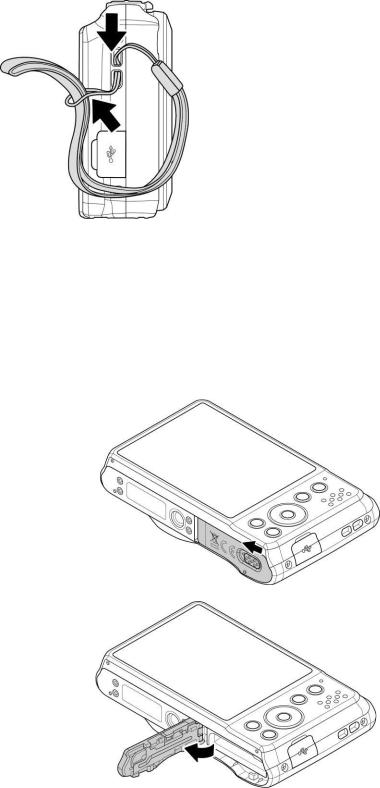
Getting Started
Attach the Camera Strap
Wrist strap
Inserting the Battery
Follow these instructions to insert the rechargeable battery into the battery/memory card compartment.
Please read "Battery Information" on page 5 before inserting/removing batteries.
1.Make sure the power is off before inserting the battery.
2.Unlock and open the battery/memory card compartment at the bottom of the camera.
17
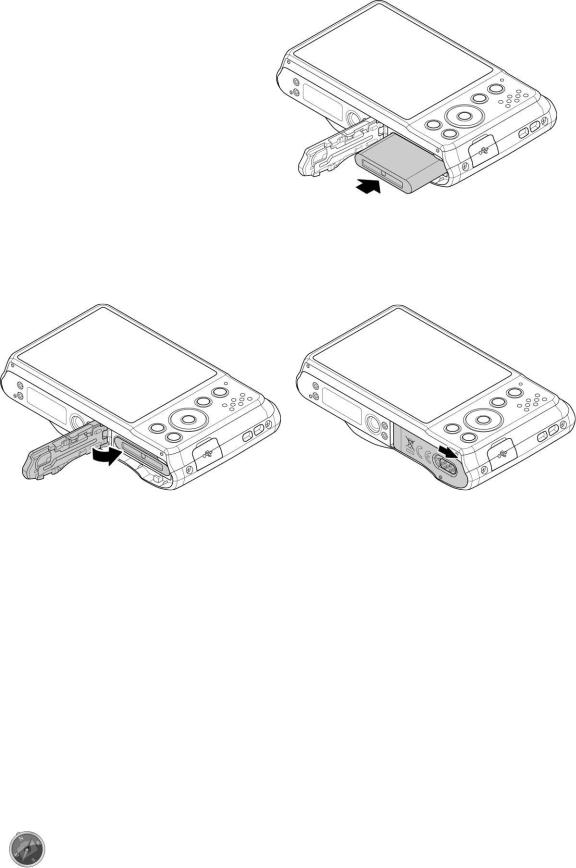
3.Insert the battery into the compartment with the terminal facing inside the camera with correct orientation as shown.
4.Close and lock the battery/memory card compartment. In order to prevent the battery from dropping, please make sure the compartment is locked firmly.
Camera Memory
Internal memory
Your camera is equipped with 64 MB of internal memory. Users can store files up to approximately 24 MB. If there is no memory card inserted in the memory card slot, all images and videos recorded are automatically stored in the internal memory.
External storage
Your camera supports Micro SD cards of up to 4 GB in size. It also supports Micro SDHC cards with a maximum capacity of 32 GB and Micro SDXC cards with a maximum capacity of 64 GB. If there is a storage card inserted in the memory slot, the camera automatically saves all images and videos onto the external storage card. The icon  indicates the camera is using the Micro SD card.
indicates the camera is using the Micro SD card.
Not all cards will be compatible with your camera. When purchasing a card, please check the card's specifications and take the camera
with you.
18

Inserting an Micro
SD/SDHC/SDXC Memory Card
Expand your camera’s storage by using Micro SD, Micro SDHC or Micro SDXC memory cards.
1.Unlock and open the Battery/memory card compartment at the bottom of the camera.
2.Insert the Micro SD/SDHC/SDXC card into the memory card slot with the metallic part facing the back side of the camera.
3.Push the Micro SD/SDHC/SDXC card into the memory slot until it clicks into place.
4.Close and lock the Battery/memory card compartment.
To remove the Micro SD/SDHC/SDXC card
5.Unlock and open the battery/memory card compartment.
6.Gently push the card until it pops out.
7.Pull out the card carefully.
•Windows 2000/XP does not support Micro SDXC card (exFAT format). But in Windows XP (Service Pack 2 or 3), you can download exFAT patch update to support Micro SDXC card.
•To use the Micro SDXC card with Mac OS, the OS version should be 10.5 or higher.
•The memory card that is not inserted correctly may cause damage to the camera. Please be careful when inserting the memory card.
•To prevent children from swallowing the memory card, please keep the memory card out of reach of children.
19
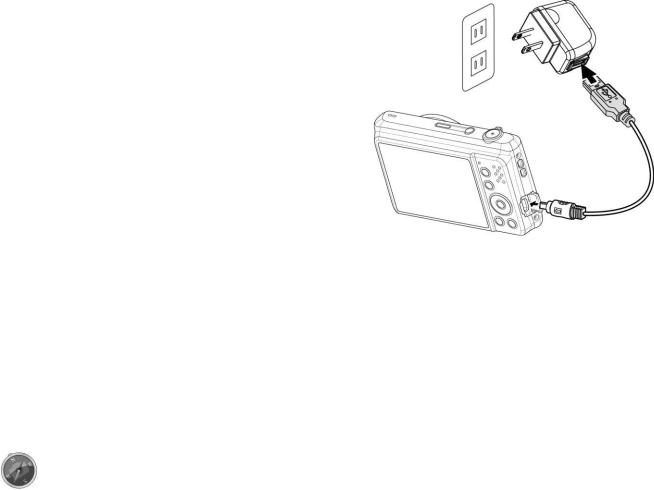
Charging the Battery by USB
You can also charge the battery by connecting the USB cable to your camera and PC.
1.Connect the camera with the USB cable as shown.
2.Connect the other end with the USB adapter and plug it into a power outlet or into the PCs USB port.
•When the battery is charging, the LED indicator flashes.
•When the battery is fully charged, the LED indicator goes off.
•When the battery is unusually charged, the LED indicator flashes rapidly.
•When the camera charges without the battery inside, the LED indicator goes off.
•It's recommended to not operate the camera when charging. Actual charging time depends on current battery capacity and charging conditions.
•You can also charge the battery with an Apple adapter. Its power output meets the standard 5V/500mA.
•If the battery is removed during charging, it will only recover charging after you unplug and replug the USB.
Turning the Power On and Off
There are two ways to turn on the camera:
•The startup image displays briefly and the startup sound plays if enabled. The zoom lens extends and the camera is turned on in Record mode.
•The camera is turned on in Playback mode. The zoom lens is not extended. To turn off the camera, press the Power button.
See "Modes" on page 21 to know more about Record and Playback mode.
20

Initial Settings
When you turn on your camera for the first time, you will be asked to do the initial settings of your camera. First is the setup of language menu. Specify in which language menus and messages are to be displayed in on the LCD monitor.
Setting the Language
1.Press  ,
,  ,
, or
or  to move through the selection.
to move through the selection.
2.Select a language, and then press OK to apply.
Setting the Date & Time
1.Press  or
or  to move through the selection.
to move through the selection.
2.Press  or
or  keys to change the value for the date and time.
keys to change the value for the date and time.
3.Press OK to apply.
4.If necessary, press  to cancel and return to the menu. Now, you are ready to start taking images and videos.
to cancel and return to the menu. Now, you are ready to start taking images and videos.
Holding down  or
or  keys to change the values continuously.
keys to change the values continuously.
Modes
Your camera has three modes:
Record Mode
This is the default mode when you turn on the camera every time. You are able to take images in this mode.
Playback mode
Press the Playback button  after the camera is turned on to view and edit captured images or playback videos. The recording of voice memos attached to images is available in this mode.
after the camera is turned on to view and edit captured images or playback videos. The recording of voice memos attached to images is available in this mode.
Movie mode
Press the Movie button  after the camera is turned on to start/stop recording video in this mode.
after the camera is turned on to start/stop recording video in this mode.
21
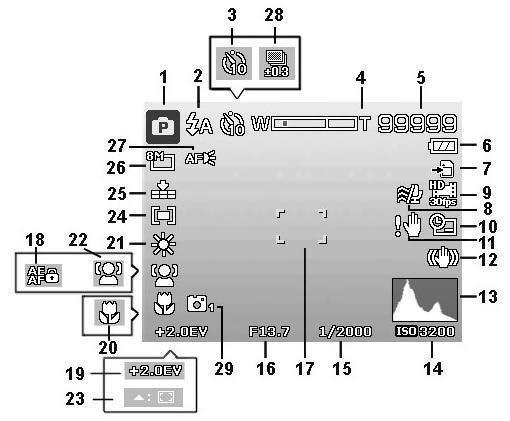
Using the LCD monitor
The LCD monitor shows all important information regarding camera settings as well as the visual image of your image or video. The display on the LCD monitor is called the On Screen Display or OSD.
LCD Monitor Layout
Photo Mode Screen Layout
|
No. |
|
Item |
|
Description |
|
|
|
|||
|
|
|
|
|
|
|
|
|
|
|
|
|
1 |
|
Record Mode |
|
Indicates the current mode. |
|
|
|
|
|
|
2 |
|
Flash |
|
Indicates flash settings. |
|
|
|
|
|
|
|
|
|
|
|
|
|
|
3 |
|
Self-timer |
|
Indicates self-timer settings. |
|
|
|
|
|
|
4 |
|
Zoom indicator |
|
Displays zoom. |
|
|
|
|
|
|
|
|
|
|
|
|
|
|
5 |
|
Shots remaining |
|
Indicates the remaining shots available. |
|
|
|
|
||
|
|
|
|
|
|
6 |
|
Battery |
|
Indicates battery level. |
|
|
|
|
|
|
|
|
7 |
|
Storage media |
|
Indicates current storage media in use. |
|
|
|
|||
|
|
|
|
|
|
|
|
|
|
22 |
|
8 |
|
Wind Cut |
|
Reduces wind noise during movie recording. |
|
|
|
|
|
|
|
|
9 |
|
Movie size |
|
Indicates movie size. |
|
|
|
|||
|
|
|
|
|
|
10 |
|
Date stamp |
|
Indicates date stamp is enabled. |
|
|
|
|
|
|
|
|
|
|
|
|
|
|
|
|
|
|
Indicates the light is not enough and the camera is |
|
|
|
|
|
shaking, which may cause the captured image to |
|
11 |
|
Shake warning |
|
blur. If the shake warning appears, you can still |
|
|
|
capture images. However, enable Stabilizer, flashlight |
||
|
|
|
|
|
|
|
|
|
|
|
or use of a tripod is recommended to stabilize the |
|
|
|
|
|
camera. |
12 |
|
Stabilizer |
|
Indicates stabilizer function is enabled. |
|
|
|
|
|
|
|
|
|
|
|
|
|
|
13 |
|
Histogram |
|
Graphic display of Brightness. |
|
|
|
|
|
|
14 |
|
ISO |
|
Displays ISO settings. |
|
|
|
|
|
|
|
|
|
|
|
|
|
|
15 |
|
Shutter speed |
|
Displays shutter speed settings. |
|
|
|
|
|
|
16 |
|
Aperture value |
|
Displays aperture settings. |
|
|
|
|
|
|
|
|
|
|
|
|
|
|
17 |
|
Focus area |
|
Indicates focus area. |
|
|
|
|
|
|
18 |
|
AE/AF Lock |
|
Indicates AE/AF Lock is enabled. |
|
|
|
|
|
|
|
|
19 |
|
EV |
|
Displays exposure compensation settings. |
|
|
|
|||
|
|
Compensation |
|
||
|
|
|
|
|
|
|
|
|
|
|
|
20 |
|
Focus mode |
|
Indicates focus is enabled. |
|
|
|
|
|
|
|
|
|
|
|
|
|
|
21 |
|
White balance |
|
Displays white balance settings. |
|
|
|
|
|
|
22 |
|
Face tracking |
|
Indicates face tracking is enabled. |
|
|
|
|
|
|
|
|
|
|
|
|
|
|
23 |
|
Tracking AF |
|
Indicates tracking AF is enabled. |
|
|
|
|
|
|
24 |
|
Metering |
|
Displays metering settings. |
|
|
|
|
|
|
|
|
|
|
|
|
|
|
25 |
|
Quality |
|
Displays quality settings. |
|
|
|
|
|
|
26 |
|
Photo size |
|
Displays photo size settings. |
|
|
|
|
|
|
|
|
|
|
|
|
|
|
27 |
|
AF lamp |
|
Indicates AF lamp is enabled. |
|
|
|
|
|
|
28 |
|
Exposure |
|
Displays Exposure bracketing settings. |
|
|
bracketing |
|
|||
|
|
|
|
|
|
|
|
|
|
|
|
|
|
|
|
|
|
|
29 |
|
Stylish |
|
Indicates Stylish function is enabled. |
|
|
|
|
|
|
|
|
|
|
23 |
|

Movie Mode Screen Layout
|
|
|
|
|
Recording Layout |
|
|
|
|
|
|
|
No. |
|
Item |
|
Description |
|
|
|
|
|
|
|
1 |
|
PIV available |
|
Indicates that you can capture a screenshot without |
|
|
|
stopping movie recording. |
||
|
|
|
|
|
|
|
|
|
|
|
|
2 |
|
Recording |
|
Indicates recording status. |
|
|
status |
|
|||
|
|
|
|
|
|
|
|
|
|
|
|
|
3 |
|
Recorded |
|
Displays recorded time. |
|
|
time |
|
||
|
|
|
|
|
|
|
|
|
|
|
|
4 |
|
AE/AF lock |
|
Indicates AE/AF Lock is enabled. |
|
|
|
|
|
|
|
|
5 |
|
Key indicator |
|
Displays the commands on 4-way Navigation Control |
|
|
|
button. |
||
|
|
|
|
|
|
|
|
|
|
|
|
24
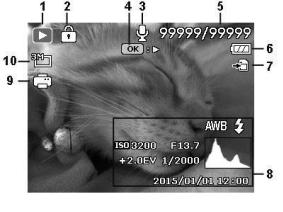
Playback Mode Screen Layout
The Playback mode display varies depending on the type of image being viewed.
Playback mode display of still images:
|
No. |
|
Item |
|
Description |
|
|
|
|||
|
|
|
|
|
|
|
1 |
|
Playback |
|
Indicates playback mode. |
|
|
mode |
|
||
|
|
|
|
|
|
|
|
|
|
|
|
2 |
|
Protect |
|
Indicates file is protected. |
|
|
|
|
|
|
|
|
3 |
|
Voice memo |
|
Indicates voice memo is attached. |
|
|
|
|
|
|
4 |
|
Button intro |
|
Indicates the button to press on the camera to play a |
|
|
|
video file. |
|||
|
|
|
|
|
|
|
|
|
|
|
|
|
5 |
|
File |
|
Indicates the file number over the total number of files |
|
|
no./Total no. |
|
in the storage card. |
|
|
|
|
|
||
|
|
|
|
|
|
6 |
|
Battery |
|
Indicates battery level. |
|
|
|
|
|
|
|
|
7 |
|
Storage |
|
Indicates used storage memory. |
|
|
media |
|
||
|
|
|
|
|
|
|
|
|
|
|
|
8 |
|
Recording |
|
Displays recording information of the file. |
|
|
information |
|
|||
|
|
|
|
|
|
|
|
|
|
|
|
|
9 |
|
DPOF |
|
Indicates the file is marked for printing. |
|
|
|
|
|
|
10 |
|
Image Size |
|
Displays the image size settings. |
|
|
|
|
|
|
|
25
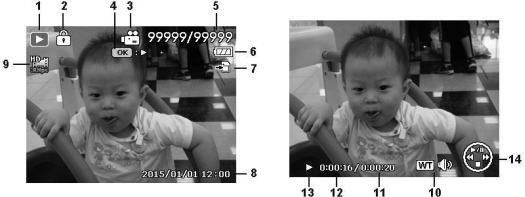
Playback mode of videos:
|
No. |
|
Item |
|
Description |
|
|
|
|
|
|
|
1 |
|
Playback mode |
|
Indicates playback mode. |
|
|
|
|
|
|
2 |
|
Protect |
|
Indicates file is protected. |
|
|
|
|
|
|
|
|
3 |
|
Video clip |
|
Indicates the file is a video. |
|
|
|
|
|
|
4 |
|
Button indicator |
|
Displays the button info of Playback mode. |
|
|
|
|
|
|
|
|
5 |
|
File no./Total no. |
|
Indicates the file number over the total number of |
|
|
|
files in the storage card. |
||
|
|
|
|
|
|
|
|
|
|
|
|
6 |
|
Battery |
|
Indicates battery level. |
|
|
|
|
|
|
|
|
7 |
|
Storage media |
|
Indicates used storage memory. |
|
|
|
|
|
|
8 |
|
Recording date & |
|
Displays the date and time of the video clip. |
|
|
|
|
time |
|
|
|
|
|
|
|
|
|
9 |
|
Video size |
|
Indicates the size of the video clip. |
|
|
|
|
|
|
10 |
|
Button intro |
|
Indicates the button to press on the camera to |
|
|
|
adjust the volume. |
|||
|
|
|
|
|
|
|
|
|
|
|
|
|
11 |
|
Video length |
|
Display the total length of the video clip. |
|
|
|
|
|
|
12 |
|
Played time |
|
Indicates the played time of the video. |
|
|
|
|
|
|
|
|
13 |
|
Playing status |
|
Displays playing status. |
|
|
|
|
|
|
14 |
|
Button intro |
|
Indicates the button to press on the camera to play |
|
|
|
a video file. |
|||
|
|
|
|
|
|
|
|
|
|
|
|
26

Recording Images and Videos
Taking Images
Now that you are familiar with your camera, you are ready to take your images. Taking images with your camera is very
simple.
1.Turn on the camera by pressing the Power button.
2.Frame the shot using the focus bracket on the LCD monitor. See illustration on the right.
3.Pressing the Shutter button down halfway automatically focuses and adjusts the exposure, and pressing the Shutter button down fully captures the images.
When the shake warning icon  appears, hold the camera steadily, with your arms at your side or use a tripod to stabilize the camera to prevent blurred images.
appears, hold the camera steadily, with your arms at your side or use a tripod to stabilize the camera to prevent blurred images.
Setting the Zoom Control
Using a combination of 12 times optical zoom and 8 times digital zoom permits zoom photography up to 96 times magnification. While the digital zoom can be a useful feature, the more an image is enlarged (zoomed), the more pixelated (grainier) the image will appear. Please refer to "Setting the Digital Zoom" on page 54 on how to setup digital zoom.
To adjust the optical zoom:
1.Spin the Zoom dial to zoom in or zoom out of an image.
2.The zoom indicator appears on the LCD monitor. 
Zoom dial
1.Spin the dial clockwise (right) to zoom in. 
2.Spin the dial counterclockwise (left) to zoom out.
27
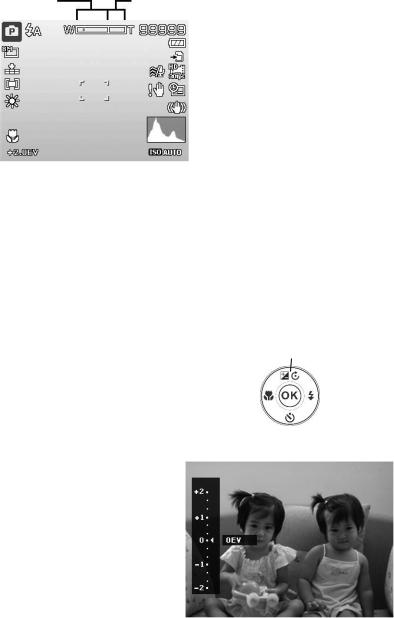
To adjust the digital zoom:
1.Activate digital zoom. See "Setting the Digital Zoom" on page 54.
2.Spin the Zoom dial clockwise/counterclockwise to set digital zooms in/out to the maximum until it stops.
3.Release the Zoom dial.
12x optical zoom |
8x digital zoom |
Using EV Compensation
Images can be captured with the overall scene intentionally made brighter or darker. These settings are used when a suitable brightness (exposure) cannot otherwise be obtained in circumstances where the difference in brightness between the subject and the background (the contrast) is large, or when the subject that you wish to capture is very small within the scene. Available for still images only.
•Press the EV/Up button on your camera to
EV/Up button launch the EV
Compensation function.
•To adjust EV settings, press the  or
or  keys to increase/decrease the value. As you adjust the settings, the LCD monitor synchronously displays the image applying the EV settings. Press the OK button to save and apply changes.
keys to increase/decrease the value. As you adjust the settings, the LCD monitor synchronously displays the image applying the EV settings. Press the OK button to save and apply changes.
•The EV setting is only available when shooting still images.
28
